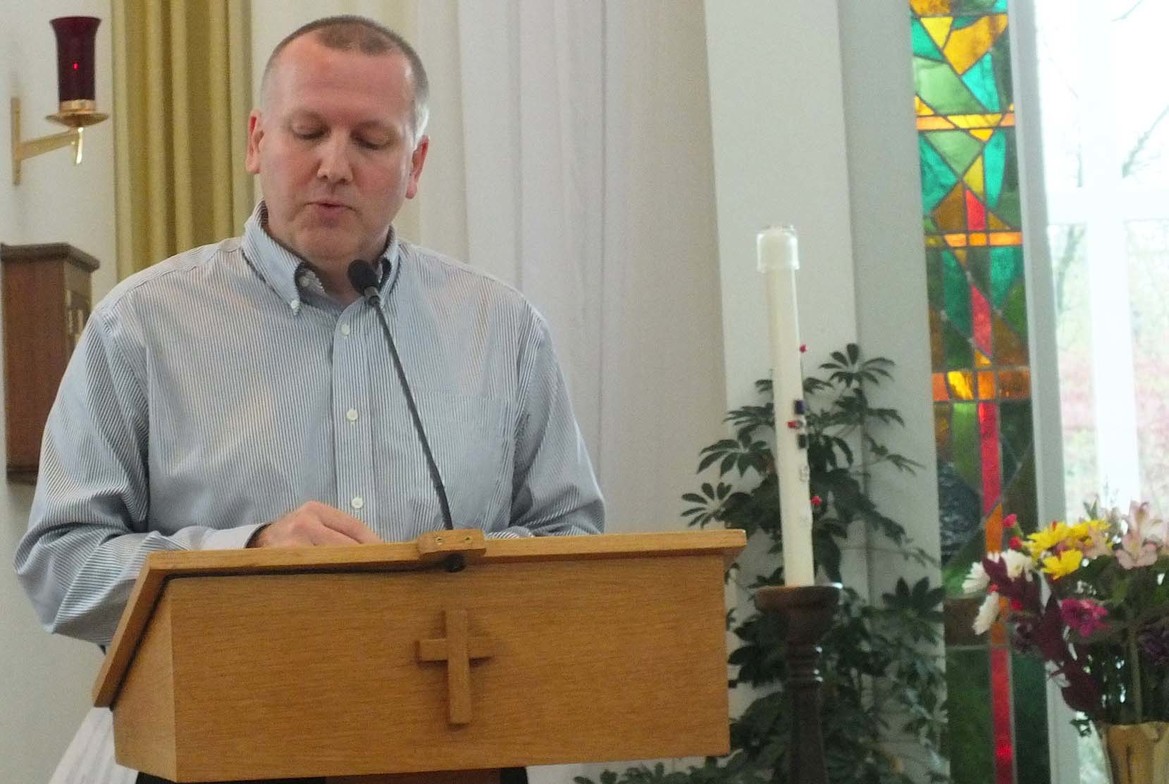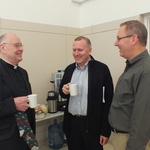The practice of gathering to prepare for the diocesan Synod is something that the diocese has observed for several years. Business is enriched by meeting to discuss and reflect upon matters that inevitably receive less detailed scrutiny at the time-constrained Synod itself.
This year, synod delegates and other diocesan and parish leaders gathered at Saint Dunstan’s, in Aldergrove, April 20th to review two important items. A White Paper has been circulating within the diocese for several months on reorganization of the diocese and its constituent bodies, and fourteen recommendations have been distilled from its content. And following the frank and open discussion of the connection and communication challenges within the diocese at the special Synod meeting last November, a task force was established by Bishop Michael to examine ways in which to foster reconnection between parishes, deaneries, archdeaconries and the diocese. Each of these was presented to those gathered at Saint Dunstan’s.The White Paper has been formed and guided by the executive archdeacon, the Ven. Douglas Fenton, through a process of review by archdeaconry meetings, standing committees and diocesan council. Its fourteen recommendations cover the way in which Synod meets, the membership of diocesan council and the standing committees under its jurisdiction, and the representation of regional interests within the diocese. One of its recommendations, that the Bishop should be requested to form a task force to examine deanery and archdeaconry boundaries, and recommend changes, has already been enacted by the diocesan council at its meeting in April. Please click to access a copy of THE RECOMMENDATIONS.
There was vigorous discussion about the recommendations. Although ratification is a matter for Synod itself, and this day was a time to review and reflect, there seems to be a strong level of support for them, indicative of the effectiveness of the consultation process. A Diocesan Mission Leadership Conference was seen to be a way of bringing parishes together to strengthen their mission and ministry. As several delegates observed, although Synod is currently held every year, it actually provides only limited opportunities for full interaction between parishes, and the mission conference gives greater opportunity for this.
Some of those present expressed concern about both representation and communication with the proposed structure of diocesan council. To be effective, it is dependent upon actively soliciting participation by regional representation. The cultural diversity, age, gender, even urban/suburban/rural differences need to be properly represented.
Trust is important. The Rev. Vivian Lam observed: "It's not a problem having a smaller group as long as we trust the membership."
Checks and balances will be built into the structure to bolster the element of trust. The Rev. Michael McGee affirmed that the presence of the chancellor, registrar or local assessor in the various bodies would provide a moderating influence. Since rewriting of canons and regulations will be required, the appropriate provisions for representation and representative decision-making will be established at that time. As further details emerge concerning the details about the proposed new standing committees (such as who would be the chairs), understanding of how this will work in practice will become clearer.
One aspect of the White Paper that has been notable is the level of interest and engagement with its content – all around the diocese. While it would have been reasonable to expect a low level of interest about diocesan reorganization from all but those involved in diocesan council and standing committees, it would appear that its people have a very healthy and active interest in the way that their diocese operates. This is also reflected in the level of interest in the other matter presented at Saint Dunstan’s.
The Reconnect Task Force has sent a survey to all of the parishes in the diocese, and all but five had responded by the time of the meeting in Saint Dunstan’s. This is a high response rate. The Ven. John Stephens, the Rev. Faun Harriman and Carol Tindall presented the results of the survey received so far, which will be available soon on the SYNOD 2013 page of the diocesan website.
The task force considered four areas of diocesan relationships: communication, caring, connecting, and cooperation. To this initial list, based upon responses received, has been added celebration.
A brief synopsis of the responses would be that: people want to see the Bishop more often; they want to show that we know how to have fun; we need more deanery meetings and synods; parishes would like to know more about what is happening in our diocese, and TOPIC is no longer the best way of disseminating time-sensitive information; confirmation and ordination should be a celebration for the whole diocese; there should be more sharing between parishes.
There is certainly a lot of interest in regional and deanery gatherings, although for this to take place the regional deans will need to be supported by regional lay leaders.
There is a strong interest in our diocese in finding new ways of connecting with one another, and it is significant that the connections envisaged are not simply between parishes and the Episcopal role implemented through the Synod office, but regional also. One of the highlights of this presentation for those present was an impromptu dialogue between Faun and Carol that demonstrated just what connecting and communicating may involve. It was very funny, completely unrehearsed, and impossible to reproduce in print, and so will have to remain a piece of oral history of the diocese! The task force still has a lot of work to do, but as John Stephens observed, it is vital that we start thinking not in terms of "the" diocese, but in terms of "our" diocese.
This was a theme that Bishop Michael, in concluding the proceedings, emphasized. He encouraged those of us present to think very carefully about what we mean when we say, "the diocese." If there is to be a critique of the diocese, we need to bear in mind that the critique is of ourselves.
Bishop Michael also remarked that the synod office staff are very dedicated and work very hard doing the things that our diocese wants. In fact, they are often overworked. He felt that it was unfortunate that some of the comments could be perceived to be disempowering and discouraging. He felt that this is not a good reflection of the hardworking nature of the staff who serve us.
In concluding, he offered this for consideration. If the people of the diocese want more Episcopal presence, is one bishop enough? Should we be thinking about different Episcopal structure, for example with a Suffragan bishop (a secondary Bishop, subordinate to the diocesan Bishop, who provides pastoral oversight for a part of the diocese)? This is something that Synod may need to ponder as Bishop Michael’s retirement looms before us.
All in all, this was an occasion that those present felt was a good step to prepare for Synod, and well worth attending, even though, as the executive archdeacon observed, it meant giving up their 4/20 day!
Images: Top, reconnect Task Force member, the Reverend Faun Harriman, with Reconnect Task Force chair, the Venerable John Stephens in the background. Upper right, Rector of St. Dunstan's, Aldergrove, the Reverend Paul Guiton. Middle left, The Reverends Vivian Lam and Michael Fuller and the Venerables, John Stephens and Douglas Fenton. Lower right, the Venerable John Stephens.
Below, The Plenary in a break-out discussion group.









